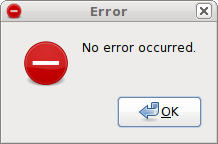 While you’re here, be sure to join my SAT prep mailing list for subscriber-only downloads and other exclusive bonuses to help raise your score!
While you’re here, be sure to join my SAT prep mailing list for subscriber-only downloads and other exclusive bonuses to help raise your score!
Choice E – the “No Error” option in the SAT writing section – everyone hates it.
Even I don’t really like it.
This article is all about the “No-Error” choice. We’ll cover relevant issues such as:
- How commonly “No Error” is correct
- How grammar fundamentals are the route to “No Error” success
- How to think about “No Error” like the people who write the SAT do
- Common tricks and traps that you’ll see again and again
- Strategies and professional advice straight from my tutoring experience
- The “No Error” mistakes you probably don’t even know you’re making
“No Error” is not a special answer choice:
You need to know this right away:
Choice E, “No Error,” is totally normal and not unusual at all.
Most students think it’s uncommon when I first ask them. Is this your subconscious assumption? Make sure to replace it with a more accurate observation: the “No Error” choice is correct about 20% of the time, just like the other 4 choices are.
A quick story: I watch students work on sections – they’ll pick choice “C” four times in a row in one particular section and never think twice about it. Seriously, no one even bats an eye. Yet those same students will balk and refuse to pick “E” even when it merely appears twice in a row!
They’ll pick the other letters four times in a row, no problem! But “E” can’t even be picked twice without being suspicious! I repeat – this is extremely common, even among extremely smart, high-scoring students with strong grammar.
Get Exclusive SAT Prep Tips!
I want to send you more tips to help your SAT score, but I need your email address to stay in touch. Enter your email below so I can send you my reports on the SAT and other subscriber-only bonuses.
You’re just as subject to this (incorrect) prejudice against “No Error” as they are, so ask yourself honestly if you’re giving choice “E” a fair chance to compete.
If you think “No Error” is unusual, or special in any distinctive way, it will make you more suspicious, nervous, and less likely to choose it when the time is right.
If you don’t see any clear mistake, have the guts to pick “No Error”:
A fellow (and highly-experienced) SAT tutor had this to say on the “No Error” issue:
“Answering (E) whenever you do not see an error is the best way to earn more points on the Error ID part of the Writing section.”
I fully agree with his logic, which is also supported on his site through the use of mathematical, statistical calculations. Basically, it comes down to the simple fact that you “win” far more than you risk “losing” because you get one point for a right answer, but only lose 1/4 of a point for a wrong answer.
I don’t like going by “statistics” on the SAT (instead, I prefer to deal with each question as it comes, on a one-by-one basis). Nevertheless, it’s at least a decent benchmark to say that each page of an SAT Writing multiple-choice section should have about 1-2 “No Error” choices on it – again, speaking statistically (1 out 5 questions ought to be “No Error.”)
Don’t let this be a straitjacket to your thinking – but it can help guide you or remind you to pick “No Error” a little more often if you are shy about it.
Only a true grammar master will ever feel comfortable with “No Error”:
 Like I said earlier, improve your grammar fundamentals if you want to know when to pick choice E.
Like I said earlier, improve your grammar fundamentals if you want to know when to pick choice E.
Why is this true?
Because – you can only know there is NO mistake if you know ALL the mistakes there COULD be.
The SAT Writing section is testing the same rules of grammar all the way through. You’re never going to face off against some magical “crazy question” where the rules are totally different.
Don’t get paranoid if you’ve studied – instead, focus on finding, or not finding, the common mistakes you learn in practice (and if you haven’t studied, then what makes you think you deserve a great score?)
A 5-step formula that will improve your SAT Writing score:
You have to be able to predict, identify, name, explain, and repair – that’s the formula for total mastery of “No Error” and the entire SAT Writing section in general.
- Predict the mistakes based on knowledge of the test and experience
- Identify where something has been grammatically “broken”
- Name the mistake. Optional, but extremely helpful for building confidence and speed. (e.g. “Subject-Verb Disagreement,” “Illogical Comparison,” etc.)
- Explain the mistake to yourself. This is my failsafe strategy to make sure I can provide a very logical, well-supported explanation for why I’m choosing this answer above all the other ones.
- Repair the mistake. If you know how to fix it, and why it needs to change, then you have achieved total mastery.
By making this process an autopilot-style habit, it becomes much easier to identify the questions that don’t have a mistake in them.
Each step of the process gives us another opportunity to realize that we just can’t give a good explanation for anything being wrong… which supports “No Error” as the correct final answer.
If you can’t spot a specific error in a question, just pick E!
 One thing that will make this easier is to physically cross off answers that you’re reasonably-certain are acceptable.
One thing that will make this easier is to physically cross off answers that you’re reasonably-certain are acceptable.
Be sure you’ve thought about what could go wrong with an answer and made sure that mistake is not happening.
If this advice leaves you feeling like “but I never know what mistakes might be happening,” then you absolutely must download my SAT grammar book – it will make your life much easier.
Know the most common “weird-sounding but not WRONG” phrases:
- “Long since,” as in “Long-since forgotten, …”
- “That” used as a noun (meaning “the fact that…” as in “That Obama was re-elected indicates that at least some of the nation is satisfied with his leadership)
- “Idioms” or acceptable phrases that you may be unfamiliar with
You can read more about these “weird-sounding phrases” at the site of one of my favorite SAT tutors by following this link.
Check your No Errors first, but don’t change answers out of nervousness:
If it makes you feel better, make it part of your plan to check your “No Errors” first once you’ve finished the section.
One important side note – it’s only human to be prone to getting nervous and changing your answer away from “No Error” at the last second.
Basically, you psych yourself out, and convince yourself that the “weird-sounding” choice in the sentence was actually wrong.
Fight this tendency, and only change your answer if you have what I call a “Lightbulb Moment” or “AHA!” where you suddenly feel something click that you missed before.
It’s a very distinctive feeling, these lightbulb moments. If you don’t feel a sudden “click” of understanding – often triggered by some seemingly-minor detail you overlooked the first time – then do not change your answer on a whim. You will regret it!!
Rereading a “No Error” too many times will actually just make you crazy:
Rereading a question too many times will hurt you, especially if “No Error” actually turns out to be the correct answer.

Re-reading wastes time.
It wastes mental energy.
Most importantly for our purposes, normal stuff starts to sound weird.
(Have you ever repeated a word, like, 200 times without stopping? Say “Cow” or “Milk” over and over and you will very quickly come to realize that everything in English sounds bizarre when repeated too many times).
Remember that they’re trying to trick you:
You have to know in your heart that the “No Error” questions virtually always “sound weird” – that’s the whole point! That’s why they’re tricky! The SAT is tricky, tricky, tricky!
Put yourself in their shoes. Are you going to make “No Error” be the right answer for a basic, easy, clear and normal-sounding sentence? HELL no.
The entire personality of the SAT test is focused around being tricky and obnoxious. When you see “No Error” in this light, it actually makes a lot more sense that you’re going to be picking it even when sentences “sound weird” to you.
“Sounding weird” is not a real grammar mistake.
Just because you can or would say the same sentence a little differently does not mean that there is an actual error.
There are many, many ways to say the same idea with different words! Some of those ways will be simple and easy, while other ways will be more wordy and complex – but that does not make them wrong, necessarily.
Many of my students react incorrectly to “No Error” questions by starting their explanations with “Well, I would say it this way:”
I want to shout, “Guess what?! The language doesn’t revolve around your preferences, it revolves around rules!”
Just because you’d like it to look differently, doesn’t mean that it has to change! And that’s what we’re after in this section of the SAT Writing – we only pick answers that must be different.
Must be different. Not “could be” different.
Don’t let them draw your attention away from picking “No Error”:
Now, I’m actually going to leap off this idea to give you another strategic concept.
Although we know now that you can’t pick answers just because they “sound wrong,” you can apply the SAT-test-writer-psychology concept in a way that helps you raise your score.
Remember – the SAT writers are mainly proud of their trickiness. They’re constantly trying to draw your attention in unhelpful ways – away from right answers, and towards wrong answers.
The know that “No Error” is a choice of last resort for students. No one ever picks “No Error” unless they’ve given up on all the other choices.
That means that if the SAT writers can just distract you for even one second and make you nervous about a different choice, you’d probably prefer to pick an “error” in choice A, B, C, or D than select your last-ditch option of E, “No Error.”
So, if the true answer to a question is “No Error,” the SAT writers will focus all their energy on drawing your attention to other answer choices, and the way they do this of course is by making the other choices “sound weird.”
But check it out – this can reveal their poker hand and help us call their bluff – because if we have a question, and we don’t see any of the major grammar rules being broken, but several other answers sound weird… couldn’t that very likely mean that the SAT-writer was trying their hardest to draw our attention?
In other words, if you don’t see anything specifically wrong, but several of the answer choices still give you a bad feeling, then it’s entirely possible you’re on a legitimate “No Error” question.
Feelings are not part of grammar; they’re part of psychology.
You need to play by grammar rules, not psychology rules.
Multiple “weird-sounding” answer choices without a clear grammar error lead me to very strongly suspect “No Error” will be correct.
Tricky No-Errors are commonly at the end of the section:
By the way – this particular style of trickiness is most commonly seen near the end of a Writing section.

As you get closer to the end of any Writing section, it’s pretty predictable that more and more of the above-mentioned situation will arise. The trickiest “No Errors” always seem to show up in the last 5-6 questions in a section.
When you’re fatigued and nervous, you’ll be less likely to trust “No Error.” The test-authors know this and are trying to exploit it. Don’t let them.
Unless, you know, you want to get a lower score.
My “Home-Field Advantage” Grammar Strategy:
A secret trick/strategy I invented, and really like, is to write my own mental sentence using the weird-sounding word or phrase in the question. I call this “putting things on home turf” since I’m trying to remove the SAT’s home-field advantage.
For example, I might be worried about the phrase “Long since” in the following sentence:
“Long since forgotten, and from a single block of metal shaped, the mechanic’s creation stood rusting in the yard.”
To put things on “home turf” I make up a new and simpler sentence and hope that the phrase sounds really weird or totally normal to me. In this case, I have a kind of History-Channel-Announcer-Voice going in my head:
“The Roman Empire is long since forgotten.”
It sounds fine to me – in fact it sounds familiar, comfortable, like I’ve heard it before somewhere. This is reassuring to me. Is it an exact science? No – but now I’m at least a little more likely to pick “No Error,” which would be the correct answer.
Don’t think you’re “special!”
Alright folks – that’s all for now – but one last thing before I sign off today.
Don’t be the one that thinks “sure, I bet other students do that, but I’m much smarter than they are.”
Just don’t. Believe me, your arrogance will be your undoing.
Everyone, every single student I’ve ever had (200+ of them), would benefit from re-reading this article until they’ve internalized it. It’s something we’re all at risk of until we’ve gotten several perfect Writing scores under our belt.
To truly master SAT Writing and the “No-Error” choice with my help, order my book SAT Grammar Crammer: Top 12 Rules of SAT Writing!
Further Reading:
What Exactly is on the SAT Writing Section?
SAT Writing Strategy: Eliminating Details
SAT Writing Grammar Rules: Subject-Verb Agreement
Be Humble About the SAT
Additional Resources:
SAT Grammar Crammer: Top 12 Rules of SAT Writing (e-Book)
Hey wait! Before you go, join my SAT prep mailing list so we can stay in touch. I’ll send you subscriber-only content like my Urgent Report on SAT Reading and other exclusive tips!
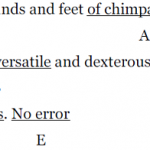
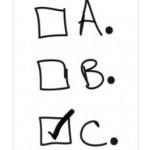





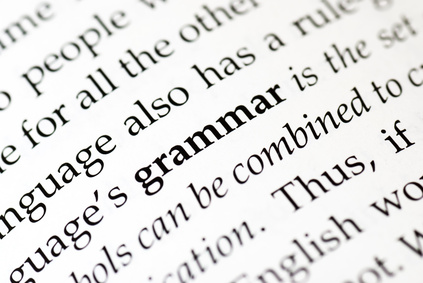

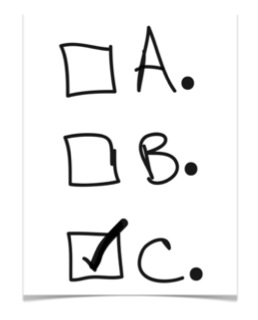








Find Me on Social Media